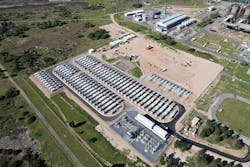Wärtsilä, AGL Energy Finish Construction on 25-MWh Torrens Island Energy Storage in Australia
Power generation and infrastructure firm Wärtsilä and utility partner AGL Energy have completed construction on a 250-MW/250-MWh battery energy storage facility at Torrens Island in South Australia.
The flexible capacity offered by the Torrens Island project will help offset the intermittency of renewable energy resources installed nearby. The battery storage system can provide enough electricity to power close to 75,000 homes for one hour, with potential to extend that duration to four hours in the future.
“Australia’s energy transition is all about balance,” Andrew Tang, vice president of energy storage and optimization at Wärtsilä, said a company statement announcing the end of the construction phase.
“This landmark project is helping Australia take a major step towards a 100% renewable grid and its net-zero emissions target,” Tang added. “We’re proud to say our energy storage system is helping to maintain reliable and affordable electricity for South Australians.”
The Torrens Island system will operate in grid-following mode. Grid-following inverters for the energy resource synchronize output with the overall grid voltage and frequency, but cannot operate alone in island mode separate from main grid connection.
The South Australia BESS could someday transition to grid-forming mode (virtual synchronous generation – VSG), the companies say. The difference with grid-forming mode is that inverters can provide power for microgrids and operate as an islanded (grid-disconnected) resource, according to reports.
Wärtsilä has done numerous energy transition projects with AGL and others in Australia, including the Barker Inlet Power Station also on Torrens Island. The 211-MW Barker Inlet is comprised of 12 Wärtsilä dual-fuel 50DF gas-fired engines to provide dispatchable and flexible power generation as needed.
About the Author
Rod Walton, EnergyTech Managing Editor
Managing Editor
For EnergyTech editorial inquiries, please contact Managing Editor Rod Walton at [email protected].
Rod Walton has spent 17 years covering the energy industry as a newspaper and trade journalist. He formerly was energy writer and business editor at the Tulsa World. Later, he spent six years covering the electricity power sector for Pennwell and Clarion Events. He joined Endeavor and EnergyTech in November 2021.
Walton earned his Bachelors degree in journalism from the University of Oklahoma. His career stops include the Moore American, Bartlesville Examiner-Enterprise, Wagoner Tribune and Tulsa World.
EnergyTech is focused on the mission critical and large-scale energy users and their sustainability and resiliency goals. These include the commercial and industrial sectors, as well as the military, universities, data centers and microgrids. The C&I sectors together account for close to 30 percent of greenhouse gas emissions in the U.S.
He was named Managing Editor for Microgrid Knowledge and EnergyTech starting July 1, 2023
Many large-scale energy users such as Fortune 500 companies, and mission-critical users such as military bases, universities, healthcare facilities, public safety and data centers, shifting their energy priorities to reach net-zero carbon goals within the coming decades. These include plans for renewable energy power purchase agreements, but also on-site resiliency projects such as microgrids, combined heat and power, rooftop solar, energy storage, digitalization and building efficiency upgrades.

